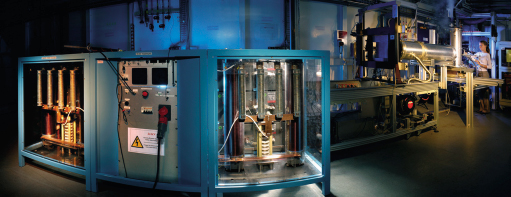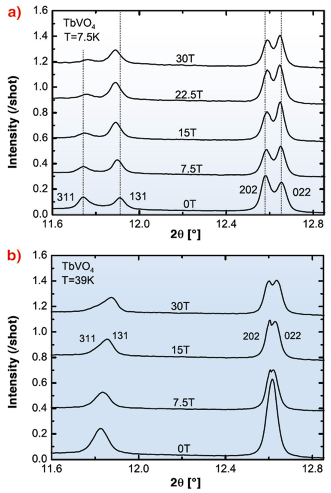- Home
- Users & Science
- Scientific Documentation
- ESRF Highlights
- ESRF Highlights 2006
- Materials Science
- Synchrotron X-ray powder diffraction studies in pulsed magnetic fields
Synchrotron X-ray powder diffraction studies in pulsed magnetic fields
X-ray diffraction (XRD) is by far the dominant method for the determination of crystal structures. Until recently [1] there was no experimental tool for structure determinations under magnetic fields higher than 17 T, the highest magnetic field available at synchrotron or neutron facilities. Here we present the first XRD experiments up to 30 T. This technique can be extended to reach 60 T.
For our pilot studies we have chosen to combine synchrotron X-ray powder diffraction with pulsed magnetic fields. Our experiments were performed on the DUBBLE CRG-beamline (BM26B), using a pulsed field generator and high field magnet developed at the LNCMP, Toulouse (Figure 36). Magnetic fields up to 30 T were generated in the load magnet with the coil horizontally mounted into a cryostat. The beam axis was along the bore of the magnet (Faraday geometry).
 |
|
Fig. 36: Photo showing, from left to right, the generator, X-ray detector and magnet/sample cryostat assembly (photo credit: D. Michon, Artechnique, Grenoble). |
Terbium ortho-vanadate, TbVO4 is a textbook example for a cooperative Jahn-Teller transition (JT) mediated by quadrupolar interactions between the 4f moments [2]. At high temperatures TbVO4 crystallises in the tetragonal zircon structure. Upon lowering the temperature through TJT = 33 K it undergoes a cooperative JT transition: the crystal spontaneously distorts along the [110] direction to orthorhombic symmetry. Samples of TbVO4 were kindly provided by P.C. Canfield of Ames Laboratory (USA).
Powder X-ray diffraction diagrams were recorded on a MAR345 online image plate using an X-ray photon energy of 21 keV. Figure 37 shows the field dependence of the X-ray spectrum, as observed at T = 7.5 K (left) and T = 39 K (right) for different magnetic fields. We first consider the zero field measurements at 39 K and 7.5 K. In the high temperature phase we observe two Bragg reflections with Miller indices (using the high temperature tetragonal unit cell, subscript tet) (211)tet near 11.8 deg and (112)tet near 12.6 deg. The low temperature distortion due to the Jahn-Teller effect is clearly visible as a splitting of these peaks: (211)tet ![]() (311)ortho + (131)ortho and (112)tet
(311)ortho + (131)ortho and (112)tet ![]() (202)ortho + (022)ortho, where the subscript ortho signifies indexing with respect to the orthorhombic unit cell. Next, we investigate the evolution of the spectra as function of applied field at low temperature, T ≈ 7.5 K (Figure 37a). Immediately visible is a change in the relative amplitude of the high- and low-angle partners. We attribute this to the preferential population of domains, due to an in-plane (aortho vs. bortho) magneto-crystalline anisotropy of TbVO4. The splitting decreases with increasing field, indicating that the Jahn-Teller effect is suppressed. In the high temperature spectra (Figure 37b) we observed that upon applying the magnetic field a splitting ((202)/(022)ortho pair) appears, and that a preferential domain population develops ((311)/(131)ortho pair), i.e. the magnetic field induces the Jahn-Teller state. At B = 30 T the magnitude of the distortion is similar for both temperatures. At all temperatures the peaks broaden as the field is applied. This is due to the strong dependence of the phase diagram on the angle between the magnetic field and the sample’s c-axis.
(202)ortho + (022)ortho, where the subscript ortho signifies indexing with respect to the orthorhombic unit cell. Next, we investigate the evolution of the spectra as function of applied field at low temperature, T ≈ 7.5 K (Figure 37a). Immediately visible is a change in the relative amplitude of the high- and low-angle partners. We attribute this to the preferential population of domains, due to an in-plane (aortho vs. bortho) magneto-crystalline anisotropy of TbVO4. The splitting decreases with increasing field, indicating that the Jahn-Teller effect is suppressed. In the high temperature spectra (Figure 37b) we observed that upon applying the magnetic field a splitting ((202)/(022)ortho pair) appears, and that a preferential domain population develops ((311)/(131)ortho pair), i.e. the magnetic field induces the Jahn-Teller state. At B = 30 T the magnitude of the distortion is similar for both temperatures. At all temperatures the peaks broaden as the field is applied. This is due to the strong dependence of the phase diagram on the angle between the magnetic field and the sample’s c-axis.
 |
|
Fig. 37:Field dependence of the diffraction pattern at T = 7.5 K and T = 39 K. The graphs are shifted vertically for clarity. |
Our experiment thus shows that the magnetic field pulse modified the Jahn-Teller distortion in TbVO4, and that these changes can be detected using X-ray powder diffraction at a synchrotron source. An analysis of these data will be published.
References
[1] Y.H. Matsuda, Y. Ueda, H. Nojiri, T. Takahashi, T. Inami, K. Ohwada, Y. Murakami, T. Arima, Physica B 346–347 519 (2004); Y. Narumi, K. Kindo, K. Katsumata, M. Kawauchi, C. Broennimann, U. Staub, H. Toyokawa, Y. Tanaka, A. Kikkawa, T. Yamamoto, M. Hagiwara, T. Ishikawa, H. Kitamura, J. Syn. Rad. 13, 271 (2006).
[2] G. A. Gehring and K. A. Gehring, Rep. Prog. Phys. 38, 1 (1975).
Principal Publication and Authors
P. Frings (a), J. Vanacken (b), C. Detlefs (c), F. Duc (a), J.E. Lorenzo (d), M. Nardone (a), J. Billette (a), A. Zitouni (a), W. Bras (e) and G.L.J.A. Rikken (a), Rev. Sci. Instr. 77, 063903 (2006).
(a) Laboratoire National des Champs Magnétiques Pulsés, Toulouse (France)
(b) Pulsveldengroep, Institute for Nanoscale Physics and Chemistry, Leuven (Belgium)
(c) ESRF
(d) Laboratoire de Cristallographie, CNRS, Grenoble (France)
(e) Dubble CRG, ESRF



